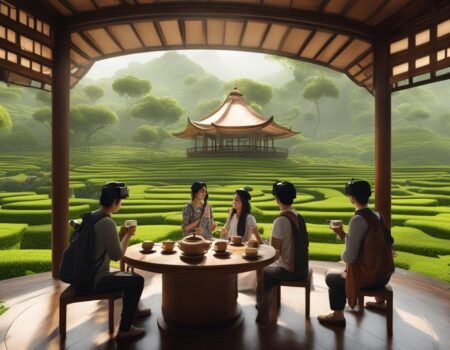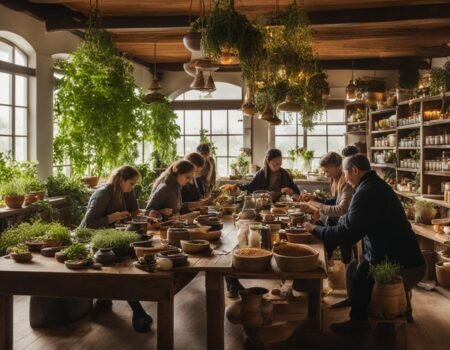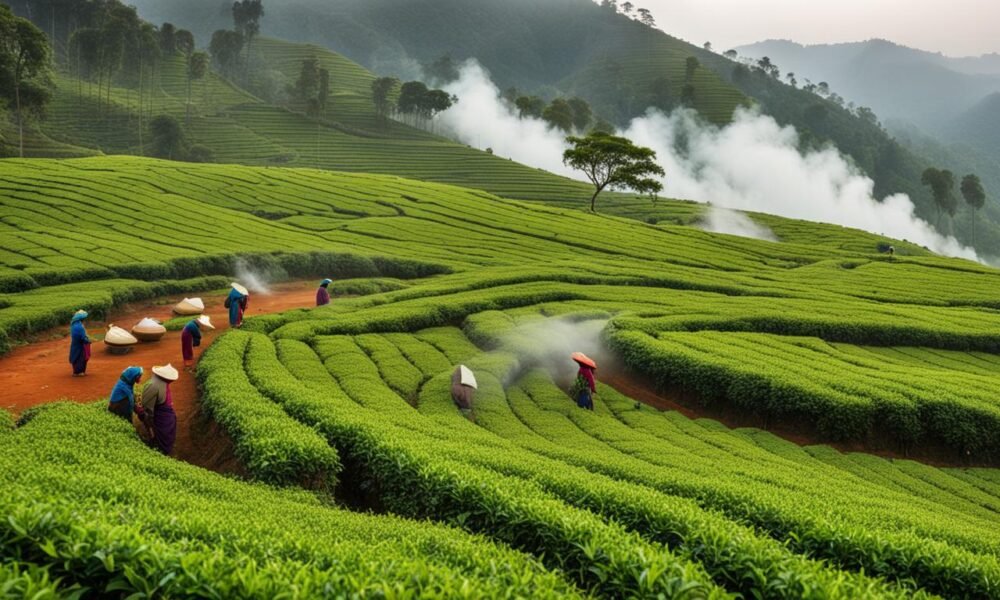
Preserving Traditional Tea Cultures through Tea Estates
Tea, a beverage cherished across the globe for centuries, has a remarkable history that weaves through cultures, traditions, and civilizations. Join us on an immersive journey as we explore the rich heritage of tea, its profound impact on our lives, and the beauty that lies within each steeped leaf.
Tea estates, steeped in tradition and customs, play a vital role in preserving the essence of tea culture. From the sprawling fields where the tea leaves are grown to the meticulous process of harvesting and production, these estates ensure that the time-honored practices of tea cultivation are upheld and celebrated. Each cup of tea tells a story, connecting us to the history and craftsmanship that has been passed down through generations.
Key Takeaways:
- Tea estates are guardians of traditional tea cultures and customs.
- They preserve the time-honored practices of tea cultivation.
- Tea estates showcase the craftsmanship and heritage behind each cup of tea.
- Through tea estates, we can experience the profound impact of tea on our lives.
- Preserving tea estate traditions ensures the continuity of tea culture for future generations.
Discovering Mindfulness and Well-being
Tea, often regarded as a meditative elixir, has the power to soothe the soul and elevate our senses. Through the centuries, it has been a source of tranquility and inner peace. Delving into the art of mindful tea-drinking, we uncover the therapeutic benefits and the practice of being fully present in the moment.
Sipping on a cup of tea can transport us to a place of serenity and self-awareness, making it an integral part of mindfulness practices. Tea and meditation share a harmonious relationship, both offering a path to inner reflection and serenity. We explore the connection between tea and meditation, revealing how tea ceremonies have become a form of spiritual practice.
“Tea is a reminder to slow down, to take a breath, and to appreciate the simple pleasures of life.” – Anonymous
Mindful tea-drinking enhances the meditation experience, allowing practitioners to be fully present and attuned to the sensory aspects of tea. Each sip becomes a mindful act, where every aroma, taste, and texture is savored, fostering a deep connection with oneself and the surrounding environment.
The Benefits of Mindful Tea-Drinking
Practicing mindfulness with tea can lead to various physical and mental well-being benefits. Here are some of the advantages:
- Reduced stress and anxiety
- Enhanced focus and concentration
- Promoted relaxation and calmness
- Improved digestion and gut health
- Inspired creativity and clarity of mind
Exploring Mindful Tea Ceremonies
Across different cultures, mindful tea ceremonies have emerged as a way to cultivate presence and mindfulness. These ceremonies often involve precise rituals, slow movements, and intentional silence, allowing participants to fully immerse themselves in the experience.
Whether you choose to adopt a full tea ceremony or simply practice mindful tea-drinking in your daily life, the essence remains the same – embracing the present moment and finding tranquility in every sip.
Mindfulness and Well-being: A Cup of Serenity
Tea is not just a beverage; it is a reminder to slow down, to take a breath, and to appreciate the simple pleasures of life. Embracing the practice of mindful tea-drinking can be a transformative journey, guiding us towards a state of inner peace, serenity, and overall well-being. So, the next time you prepare a cup of tea, allow yourself to fully engage your senses, and let the tea become a pathway to mindfulness and self-discovery.
Tea as a Global Connector
Tea, with its rich history and diverse cultural adaptations, has served as a powerful catalyst for connecting people across the globe. From ancient tea ceremonies in Japan to bustling tea houses in Morocco, the traditions and customs surrounding this beloved beverage have fostered dialogue and understanding between different societies. Tea, in all its forms, has the remarkable ability to transcend language barriers and facilitate cultural exchanges.
Its role in diplomacy and international trade cannot be understated. Throughout history, tea has been used as a tool for building bridges between nations, fostering a sense of camaraderie and mutual respect. The exchange of tea traditions and stories has allowed us to gain insights into each other’s cultures, nurturing appreciation for our shared humanity.
Today, tea continues to bring people together, whether it’s through formal tea ceremonies or casual gatherings over a cup of chai. In a world that often feels divided, tea acts as a unifying force, reminding us of our interconnectedness and shared experiences. It sparks conversations, deepens friendships, and creates lasting memories. Tea truly is a cultural connector, allowing us to celebrate our similarities and embrace our differences.
The Role of Tea in Bridging Cultures
Tea has played a pivotal role in bridging cultures throughout history. Let’s dive deeper into a few examples:
- In China, tea has been a symbol of hospitality and friendship for centuries. The practice of gongfu tea, where tea is meticulously brewed and served with grace and precision, has become a way of connecting with others and demonstrating respect.
- In Britain, the afternoon tea tradition has not only been a way to enjoy a cuppa but also a platform for socializing and networking. Tea has been a common ground where individuals from different backgrounds can come together and engage in meaningful conversations.
- In Morocco, the serve of mint tea is considered an art form and an integral part of the country’s hospitality. Sharing a cup of this aromatic tea is a way to welcome guests and strengthen bonds between individuals.
These are just a few examples of how tea has transcended cultural boundaries, creating a space for connection and understanding. As we continue to explore the world of tea, let us cherish the moments it affords us to share our stories, learn from one another, and celebrate our shared humanity.
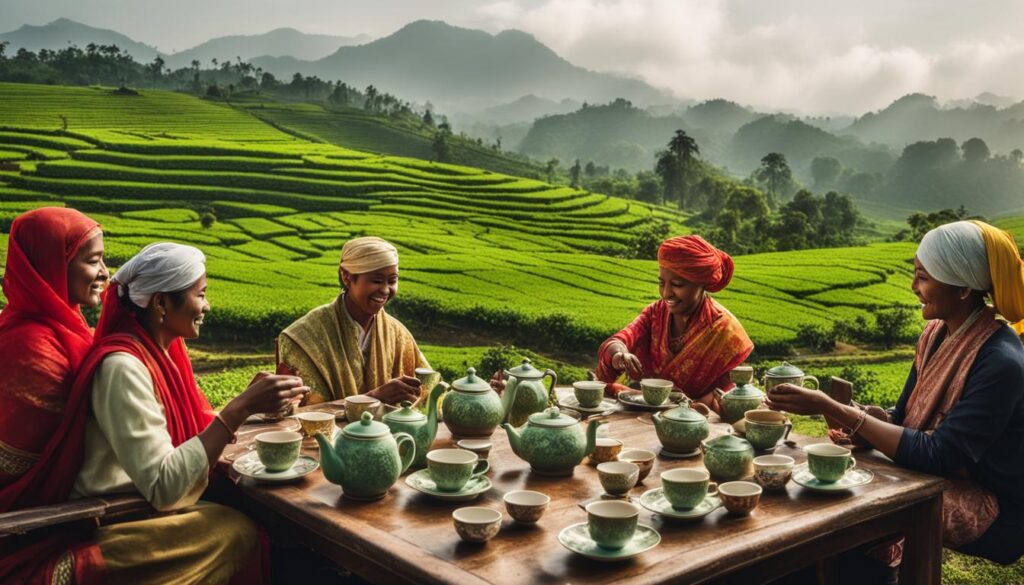
Tea Cultural Adaptations
Tea, with its journey spanning centuries and continents, has undergone fascinating cultural adaptations as it spread across the globe. From the aromatic chai in India to the vibrant matcha in Japan, we witness how tea has seamlessly integrated into local customs, embracing the unique flavors and traditions of each region.
In India, tea takes on a bold and aromatic form with the beloved chai. This spiced tea, typically prepared with a blend of black tea, milk, spices like cardamom, cinnamon, and ginger, and sweetened with sugar, is a staple in Indian households. The preparation and flavors of chai reflect the vibrant culinary heritage of India, bringing together the warmth of spices and the robustness of tea.
In Japan, the elegant art of tea-drinking is embodied by the revered matcha. This finely ground powdered green tea, prepared through a traditional ceremonial process, holds deep cultural significance. Matcha tea ceremonies, often conducted in serene tea houses, exemplify the harmony between nature, aesthetics, and spiritual practices. It is a testament to Japan’s meticulous attention to detail and reverence for simplicity.
“Through cultural adaptations, tea has become a medium for expressing the unique identities and customs of different regions, enriching the global tapestry of tea culture.”
These cultural adaptations showcase the dynamism of the tea industry and its ability to evolve while preserving its core essence. Through these expressions of tea farming traditions, we discover new flavors, rituals, and ways to connect with tea on a cultural level. It is a testament to the enduring legacy of tea and its ability to adapt and thrive in diverse contexts.
| Country | Tea Name | Preparation |
|---|---|---|
| India | Chai | Blend of black tea, milk, cardamom, cinnamon, ginger, and sugar |
| Japan | Matcha | Finely ground powdered green tea prepared through a ceremonial process |
Through cultural adaptations, tea has become a medium for expressing the unique identities and customs of different regions, enriching the global tapestry of tea culture. Whether savoring a cup of chai in India or immersing oneself in the tranquility of a matcha tea ceremony in Japan, tea enthusiasts can embark on a sensory journey that transcends borders and unites people through a shared love for this ancient beverage.
Exploring Tea Farming Traditions
Beyond the cultural adaptations of tea, it is also fascinating to delve into the diverse farming traditions that have shaped tea production. Each region has developed unique methods and practices that contribute to the flavors and characteristics of the tea produced.
In China, tea farming embraces centuries of tradition, where skilled tea farmers handpick the leaves and carefully process them to preserve their natural flavors. The intricate art of tea cultivation in China reflects a deep understanding of terroir, climate, and the delicate balance required to create teas with distinct qualities.
In contrast, tea production in Sri Lanka, known as Ceylon tea, has its own set of farming traditions. The island’s lush tea plantations, nestled amongst rolling hills, produce teas renowned for their bright flavors and rich aromas. Tea pluckers meticulously handpick tender leaves, ensuring only the finest quality leaves make it into each harvest.
Tea Farming Traditions by Country
- China: Handpicked leaves, preservation of natural flavors
- Sri Lanka: Meticulous handpicking, bright flavors, and rich aromas
These farming traditions showcase the intimate relationship between tea and the environment in which it is grown. Each region’s unique climate, soil, and agricultural practices contribute to the distinctiveness of their teas. Exploring these tea farming traditions deepens our appreciation for the expertise and craftsmanship involved in tea production.
Tea Tourism
Tea tourism has emerged as a popular trend, enticing travelers with immersive experiences in tea-growing regions. The allure of tea culture transcends borders, drawing enthusiasts from around the world to witness firsthand the captivating journey of tea cultivation and production. From walking through vast tea estates nestled amidst misty hills to exploring serene tea houses in picturesque landscapes, tea tourism offers a glimpse into the enchanting world of tea.
During tea plantation experiences, visitors have the opportunity to engage with the rich traditions and practices employed in tea estates. They can witness the meticulous process of plucking tea leaves, learn about the art of tea processing, and even participate in tea tasting sessions guided by tea experts. These interactive encounters allow travelers to develop a deeper appreciation for the age-old rituals and craftsmanship that define the tea industry.
Tea tourism also provides a platform for cultural exchange as visitors interact with local communities living in tea-growing regions. Engaging with tea producers and farmers offers a unique insight into their way of life, fostering a sense of connection and understanding. From sharing stories over a cup of freshly brewed tea to learning about the challenges faced by these communities, tea tourism becomes a transformative experience that goes beyond sightseeing.
Whether you are an avid tea connoisseur or simply seeking a unique travel experience, tea tourism allows you to immerse yourself in the captivating world of tea. It offers a perfect blend of adventure, cultural exploration, and relaxation, making it an unforgettable journey for tea lovers and curious travelers alike.
Table: Tea Tourism Activities
| Activities | Description |
|---|---|
| Tea Estate Tours | Guided tours of tea estates, providing insights into tea cultivation and processing techniques. |
| Tea Tasting Sessions | Opportunities to taste various types of tea and learn about flavor profiles and brewing methods. |
| Tea Plucking Experience | Hands-on experience in plucking tea leaves alongside skilled tea workers. |
| Tea Workshops | Interactive workshops where visitors can learn traditional brewing techniques and tea ceremony rituals. |
| Community Engagement | Opportunities to interact with local tea communities, learn about their culture, and support their livelihoods through purchasing tea directly from them. |
| Nature Walks | Exploration of the scenic landscapes surrounding tea estates, showcasing the natural beauty of the region. |
Embark on a tea tourism adventure and unlock the secrets of tea culture while creating unforgettable memories along the way. Let the aromatic scents, serene landscapes, and warm hospitality of tea-growing regions transport you to a world where tradition and nature intertwine.
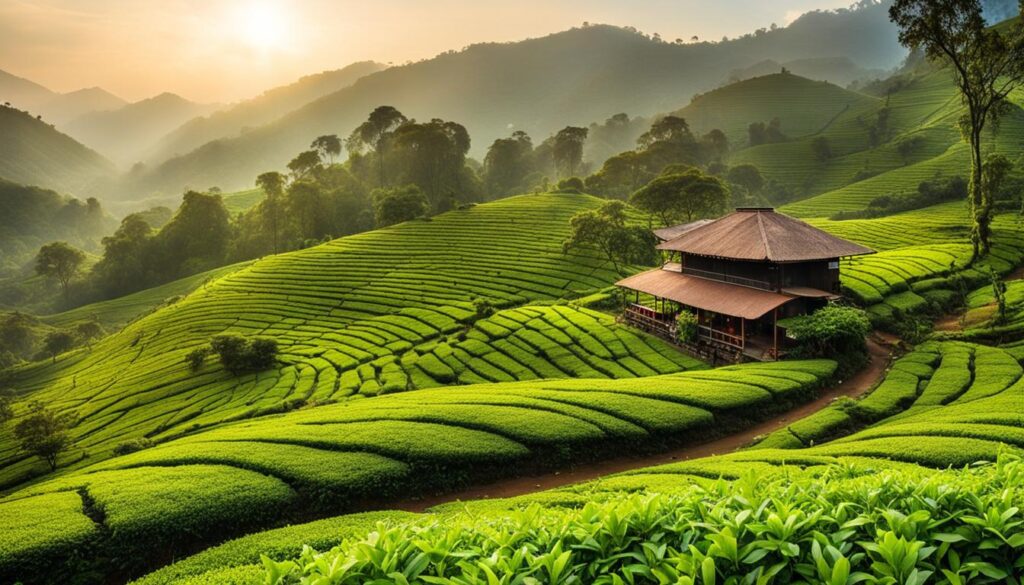
Innovations in the Tea Industry
As we embrace the timeless traditions of tea, it’s fascinating to see how the tea industry continues to evolve with innovative practices. From sustainable farming methods to groundbreaking techniques in tea processing, these innovations pave the way for a greener and more ethical future. Let’s explore the exciting advancements in the tea industry that ensure the preservation of tea traditions while embracing sustainability.
Table: Sustainable Tea Practices
| Practice | Description |
|---|---|
| Organic Farming | Eliminating the use of synthetic pesticides and fertilizers to promote biodiversity and protect the environment. |
| Biodynamic Farming | Applying holistic and regenerative farming practices that prioritize ecosystem health and sustainability. |
| Rainwater Harvesting | Collecting and utilizing rainwater in tea plantations to conserve water resources and reduce reliance on groundwater. |
| Solar Energy | Harnessing the power of the sun to meet energy needs in tea factories and reduce reliance on non-renewable sources. |
| Composting | Decomposing organic waste into nutrient-rich compost that improves soil fertility and reduces the need for chemical fertilizers. |
| Recyclable Packaging | Using eco-friendly materials for tea packaging to minimize waste and support a circular economy. |
These sustainable tea practices not only benefit the environment but also contribute to the well-being of tea-growing communities. By embracing organic and biodynamic farming, tea farmers prioritize the health and longevity of their land, ensuring that future generations can continue to enjoy the wonders of tea. Rainwater harvesting and solar energy initiatives help conserve precious resources and reduce the carbon footprint of tea production. Investing in recyclable packaging reduces waste and encourages consumers to make more sustainable choices.
Tea industry innovations pave the way for a greener and more ethical future.
Throughout history, tea has been intertwined with culture, tradition, and spirituality. The innovations in the tea industry reflect our collective responsibility to preserve these customs while adapting to the changing world. By embracing sustainable practices, the tea industry continues to honor its heritage while ensuring a brighter future for both tea lovers and the planet. Let’s raise our cups to the remarkable innovations that shape the tea industry, uniting tradition and sustainability for generations to come.
Tea Sustainability
As the world becomes more conscious of environmental issues, the tea industry is taking significant strides towards sustainability. Sustainable tea cultivation practices are being implemented to ensure the long-term well-being of both the environment and the communities that rely on tea production.
Sustainability in tea cultivation involves various aspects, including reducing the carbon footprint, conserving water resources, and promoting biodiversity. Tea farmers are adopting eco-friendly farming techniques that minimize the use of chemical pesticides and fertilizers, thus reducing the impact on the surrounding ecosystems.
In addition to environmental considerations, sustainable tea cultivation also focuses on the social and economic aspects of tea production. Fair trade practices are being encouraged to ensure that tea farmers receive fair compensation for their hard work, improving their livelihoods and fostering community development.
“Sustainable tea cultivation practices are not only beneficial for the environment but also for the long-term viability of the tea industry. By preserving the natural resources and supporting local communities, we are creating a more sustainable future for tea.”
Promoting Biodiversity in Tea Gardens
One of the key components of sustainable tea cultivation is the preservation of biodiversity. Tea gardens are being transformed into havens for native flora and fauna, creating a harmonious ecosystem that supports natural pollinators and reduces the need for harmful pesticides.
By planting shade trees and maintaining natural vegetation in and around tea gardens, tea farmers are creating habitats for birds, insects, and other wildlife. This not only helps to maintain a balanced ecosystem but also contributes to the overall health and quality of the tea leaves.
| Insect Control | Soil Conservation | Water Conservation | |
|---|---|---|---|
| Traditional Methods | Chemical pesticides | Intensive tilling | High water usage |
| Sustainable Practices | Biological pest control | Cover cropping | Rainwater harvesting |
Table: A comparison of traditional tea cultivation methods and sustainable practices.
By embracing sustainable tea cultivation, we can ensure that future generations can continue to enjoy the beauty and benefits of this beloved beverage. It is our collective responsibility to support and promote sustainable practices throughout the tea industry, from farm to cup.
Conclusion
Tea culture, with its profound significance and timeless appeal, has woven a tapestry of heritage and traditions that span the globe. At its heart, tea connects us all, inviting us to delve into its rich history, savor its health benefits, and find solace in its rituals. As we embrace the diverse world of tea, we contribute to the preservation of its timeless heritage.
Through centuries-old practices and innovative approaches, tea culture continues to thrive, enchanting tea lovers worldwide. From the tranquil tea ceremonies of Japan to the vibrant tea houses of India, each sip of tea carries the essence of cultural preservation.
As we embark on this delightful journey, let us celebrate the wisdom and beauty that lies within the world of tea. Whether you seek a moment of serenity or an immersive tea adventure, remember that tea culture unites us all, transcending boundaries and fostering a sense of unity.
So, let us raise a cup and toast to the preservation of tea heritage, knowing that with each sip, we honor the traditions of the past and embrace the spirit of tea for generations to come.
FAQ
What are some traditional tea customs found in tea estates?
Traditional tea estates often have customs such as tea ceremonies, where the preparation and serving of tea are done with great care and attention to detail. These ceremonies are steeped in cultural significance and are often accompanied by rituals and traditions that have been passed down through generations.
How does tea contribute to mindfulness and well-being?
Tea has long been associated with mindfulness and well-being due to its ability to promote relaxation and a sense of calm. The practice of mindful tea-drinking, where one focuses on the sensory experience of drinking tea, can enhance the meditative benefits of tea and help individuals cultivate a state of mindfulness in the present moment.
How does tea serve as a cultural connector?
Tea has a remarkable ability to bridge cultural gaps and foster connections between diverse societies. Whether it’s through the exchange of tea traditions, stories, or the act of sharing a cup of tea, this humble beverage has the power to bring people together, fostering dialogue, understanding, and camaraderie.
How has tea adapted to different cultures?
Tea has seamlessly integrated into different cultures, resulting in fascinating adaptations such as chai in India and matcha in Japan. These adaptations reflect the dynamic nature of tea culture, as it evolves with the changing times while still maintaining its core essence.
What can I expect from tea tourism?
Tea tourism offers immersive experiences in tea-growing regions, allowing travelers to explore vast tea estates, visit tea houses, and witness traditional tea cultivation and production methods. It provides a deeper appreciation for the age-old traditions and practices of tea, offering a unique and enchanting journey into the world of tea.
What innovations are taking place in the tea industry?
The tea industry is embracing cutting-edge technology and practices to ensure the preservation of tea traditions while embracing sustainability. From eco-friendly tea packaging to biodynamic farming methods, the industry is continually evolving to meet the needs of the environment and consumers.
How is the tea industry promoting sustainability?
The tea industry is actively implementing initiatives aimed at reducing its carbon footprint, conserving water resources, and promoting biodiversity in tea gardens. By supporting sustainable tea cultivation, we contribute to the preservation of the environment and the livelihood of tea-growing communities.
What does tea culture represent?
Tea culture represents a rich heritage, timeless appeal, and a sense of unity. It is a reflection of our shared history, traditions, and the wisdom passed down through generations. Embracing tea’s culture and rituals brings solace, inspiration, and a deeper connection to the beauty that lies within the world of tea.



